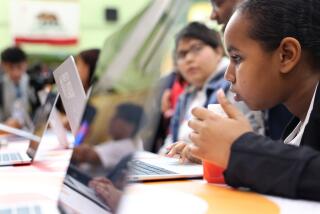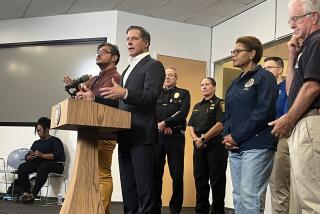President Visits Via Computer
- Share via
President Clinton was as giddy as a kid with a new toy Saturday as he tested a two-way computer video system with students at Los Angeles’ Charles W. Barrett Elementary School.
With a loud laugh, Clinton exclaimed: “It’s hard to believe it works!” when a live picture of the beaming Southland youngsters popped up on his White House computer screen.
“Hi, Mr. President!” the children bellowed in unison to the jerky image on their computer monitor. “Hi, Mr. Vice President,” one child charitably chimed to the figure standing behind Clinton, stooping over the seated president’s shoulder to fit in the picture.
In choppy, stop-action frames, Vice President Al Gore’s lips curled into a smile.
The high-tech exhibition celebrated the NetDay installation of Internet transmission lines in classrooms nationwide.
Barrett was one of two schools--the other was in Hartford, Conn.--to receive a cybervisit from the president and vice president. The South Los Angeles school is one of 10 local schools being wired by union volunteers as part of a national AFL-CIO program.
Barrett students, however, couldn’t take full advantage of their elaborate communications setup. White House officials allowed only Principal Precious Robinson and union official Miguel Contreras to speak directly to the president.
Leslie Andrews, a fifth-grader wise beyond his 11 years, said he was thrilled to see the president, but had hoped to ask him a question. “I wanted to ask him why there are so many jails and not enough schools,” he said.
The Hartford students did speak directly with Clinton. The chatty group fell silent when the president asked about their teachers’ computer skills.
Easing the awkwardness, Clinton said: “Sometimes we forget that hooking up computers isuseless if teachers don’t have the training and time to use them.”
Before talking to the students in California and Connecticut, Clinton and Gore delivered a radio address on technological issues.
Gore announced $11.8 million in “technology literacy” grants to help seven states, two U.S. territories and the Bureau of Indian Affairs to buy computer equipment and to train teachers to use the Internet. The states are Alaska, Connecticut, Kansas, Nebraska, Nevada, South Dakota and Tennessee.
And Clinton announced that he will direct all federal departments and agencies to develop educational Internet services for young people.
The president again called for the Federal Communications Commission to discount by $2 billion Internet service for schools and libraries. The FCC is to vote on the discount May 6.
The Oval Office broadcast marked the second annual national NetDay, with participants in 40 states. Since the first NetDay, 250,000 volunteers have wired 50,000 classrooms.
More to Read
Sign up for Essential California
The most important California stories and recommendations in your inbox every morning.
You may occasionally receive promotional content from the Los Angeles Times.













